Ötzi, Iceman of
the Ötzal Alps along the Tyrolean borderlands:
"On Thursday 19 September 1991 Erika and Helmut Simon, two experienced climbers from Nuremberg in Germany, were nearing the end of their walking holiday in the Italian Alps. . . . climbing the 3,516 metre Finailspitze." When "on their way down, . . .into a gully partly filled with melting ice." They had found "Sticking out of the ice was a naked body of a man."
Bryan Sykes, The Seven Daughters of Eve, p. 3.
"A five-thousand year old human body from the stone age reveals clues to more than the circumstances in which he died. Ötzi, as he was called by the retriever's of the carcass, is a window on the the materials, the beliefs, and the habits of the people with whom he shared these once ice-free hunting grounds." 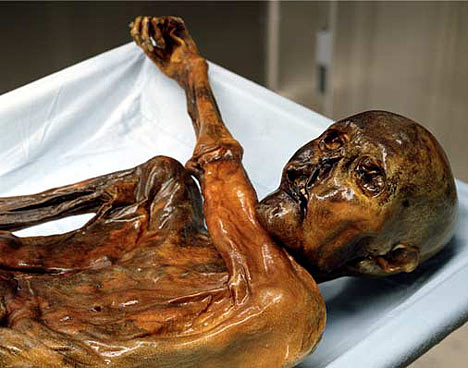
Kate Wong in Scientific American writes "It is one of the most evocative ancient corpses ever discovered: a 46 year-old man with an arrow wound in his left shoulder, whose body and belongings came to rest in a high mountain pass some 5000 years ago."
(November, 2010, p.26.)
Found in 1991 by hikers along a retreating ice edge at the Austrian-Italian border "the remains of Ötzi the ice man" ....have challenged archaeologists. Controversy over his alleged murder as revealed by the arrow wound led to further inquiry.
"A new study challenges this disaster scenario and suggests instead that the Iceman died in a fight in the valley below and was later transported to the lofty locale for a grand ceremonial send-off"
Meaning of this find:
The study suggests that "Furthermore, the unfinished weapons and grass mat that accompanied the Iceman are better explained as grave goods and a funeral shroud than as mountaineering gear." -- such as a backpack, arrows and bow. "Earlier pollen analysis also indicated a delay between the time of death and burial."
Newest interpretations of what occurred reveal a rather refined view of stone age practices. How sophisticated were the ideas and ideology of these hunting people? This question is raised by these new suggestions about his demise. Now "the investigators propose that the Iceman passed away at a low altitude in the spring and that his clansmen packed his body in ice until late summer, when they carried him up to the mountain...."
The full study can be seen in the journal Antiquity by Luca Bondioli and his team from the National Museum of Prehistory and Ethnology in Rome.
Other researchers remain unconvinced "the disaster theory remains the best explanation," asserts Klaus Oeggl of the University of Innsbruck (Austria).
Recall: "The leading theory holds that he (Ötzi) had fled there (to the pass) and froze to death after being shot with a bow and arrow during a skirmish with members of a rival tribe."
Kate Wong "The Iceman's Last Stand: The Story of a famous corpse gets a surprising twist." page 26, Scientific American, November 2010.
The frozen carcass of an international traveler found
in the Alps
In September 1991–twenty years ago this September–two German tourists uncovered Ötzi the Iceman in the Austrian alps. That was over 5000 years after poor Ötzi hung up his boots, so he quickly came to fame as the world's oldest natural human mummy.
".... Scientific research over this period has been able to tell us his last two meals, the clothes he wore and the fact that he had 57 tattoos. And just this week, they worked out he died of an arrow wound to a vital artery, and probably died within minutes."
Ötzi the Iceman's Equipment &
other tools
a bow and arrows, with quiver
the wooden frame and cords of a backpack (pannier)
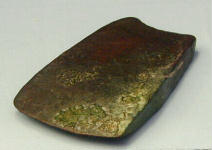 ibex bones
ibex bones
two birch-bark containers
knife with woven sheath
a belt pouch
tassel with stone bead
a copper axe
a medicine bag (with medicinal fungus)
The Details form several sources:
Ötzi's Birthplace Revealed by Scientific
Testing (10/31/03)
The latest issue of Science (10/31/03) includes an article entitled "Iceman's Origins and Wanderings."
The article presents the results when the minerals found in Ötzi's teeth, bones, and intestines
were compared to those found in soil and water samples taken from a wide area of the Tyrolean Alps. 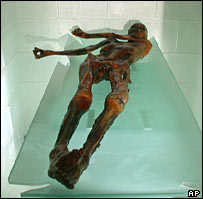
The findings suggest that Ötzi was most likely born in Italian
village of Feldthurns (north of present-day Bolzanoon the A22) but
that he lived most of his life in somewhat more northern valleys. They
deduced this by comparing the results of the minerals in his tooth enamel
with that in his bones. They also analyzed bits of mica found in his intestines
(most likely from grains ground by stone containing mica). The overall
picture that emerged was that the Iceman didn't roam more than 37 miles
or so (about 60 kilometers) from his birthplace.
For what his last meal was see:
Ötzi the Iceman was found near Hauslabjoch in the Ötzal Alps
on September 19, 1991, by two vacationing German hikers named Helmut and
Erika Simon.
Follow Ötzi's route here, First stop: Katharinaberg (or
Monte S. Caterina). It is in this tiny village (now perhaps fifty houses,
a few shops, and a church perched high on a promontory overlooking the
Schnalstal) that Ötzi began his last day.
Twelve hours before he died, scientists believe that he sipped some
water from a mountain stream in the vicinity of Katharinaberg. The water
contained a small bit of pollen from the hop hornbeam. This plant did not
grow to the north; it came only from the area around Katharinaberg. He
may have also eaten a meal of ibex (wild goat) here (see the latest news
from researchers about his last two meals)
After a great deal of scientific detective work, researchers were able
to study the remains in Ötzi's colon and identify certain substances,
including the pollen. They also found some remnants of bread and meat.
The discovery
Seeing a body lying face down in some ice, they assumed that they
had found the mummified remains of an unfortunate mountain climber. It
is sometimes difficult to recover the body of a  fallen climber, especially
if a fresh snowfall covers the area. The body freezes and does not deteriorate;
many such mummies have been recovered. Even though this might be expected,
the sight of a dead person shocked the couple.
fallen climber, especially
if a fresh snowfall covers the area. The body freezes and does not deteriorate;
many such mummies have been recovered. Even though this might be expected,
the sight of a dead person shocked the couple.
Helmut Simon wanted to take a photo, but his wife was appalled.
Still, Helmut took one photo (the last one on his roll of film)of
the body and then inspected the discovery. He saw an object or two around
the body, but they meant nothing to him.
....
When the authorities arrived, they were well aware that the glacier
had been melting. Three weeks earlier, the bodies of a man and woman who
had gone hiking in 1934 and never returned had been discovered. For this
reason, they, like the Simons, assumed that the person had died in a climbing
accident.
This explains why the Iceman's "rescuers" made quite a few careless
mistakes: they weren't trying to preserve and protect the body, they were
just trying to free it from the ice. At first, using a stick that they
found nearby (later discovered to be his bow), they attempted to pry him
free. They also tried to pull him from the ice by grabbing onto what was
left of his clothing. In the process, they shredded it.
One policeman was so anxious to free the mummy that he took a small
jackhammer to the ice, accidentally drilling a hole in the Iceman's hip.
And Pirpamer used an ice pick to finally extract the Iceman. (Brenda Fowler
gives a thorough account of all the mistakes made in Iceman, Chapter 2.)
When he was finally freed, the Iceman was forced into a coffin,
which caused his left arm to break. Then, when photographers were given
time to take pictures of the mummy in a nearby morgue, a fungus began to
spread across the Iceman's skin.
In the end, Italian and Austrian authorities were shocked to discover
that, rather than being a modern-day mountain climber, the man had died
about 3000 B.C. He quickly came to be known as the Iceman, one of the oldest
and best preserved human mummies ever found.
As Europe's oldest mummy, Ötzi the Iceman (also known as Frozen Fritz or Similaun Man) was found in the Schnalstal glacier in the Ötzal Alps on the border between Austria and Italy. He is believed to have been born around 3300 b.c. and died sometime around the age of forty-five. His body was so well preserved that scientists were able to determine what he ate before he died, cause of death, his health prior to his death and the materials used to make his clothes and shoes.
Material
Culture
The Iceman's possessions have given scientists a better look at what
life was during the Neolithic Age in Europe. Perhaps the most valuable
possession, according to many scientists, 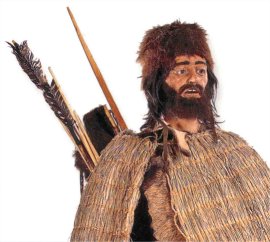 was his medicine kit. At first,
researchers thought that the medicine kit ("two walnut-sized lumps," according to author
John Noble Wilford, "with a consistency somewhere between cork and leather")
was not medicine at all--but material to start fires. However, anthropologist
Luigi Capasso reported that the material was actually a birch fungus used
as a laxative and as a natural antibiotic. If you're interested in Ötzi,
you won't want to miss this article! (The New York Times, 12/8/98,
p. F3). A photo of the medicine kit is included with the article.
was his medicine kit. At first,
researchers thought that the medicine kit ("two walnut-sized lumps," according to author
John Noble Wilford, "with a consistency somewhere between cork and leather")
was not medicine at all--but material to start fires. However, anthropologist
Luigi Capasso reported that the material was actually a birch fungus used
as a laxative and as a natural antibiotic. If you're interested in Ötzi,
you won't want to miss this article! (The New York Times, 12/8/98,
p. F3). A photo of the medicine kit is included with the article.
According to the BBC News Online, Dr Alexander Halliday of the Department
of Earth Sciences at RTH Zurich told BBC News Online:
"This is the first time that
anyone has made a comprehensive study of the migration of a human in the past. It looks like
he lived much of his life in a different valley from where he was born."
Fratricide: Evidence for Human
Aggression
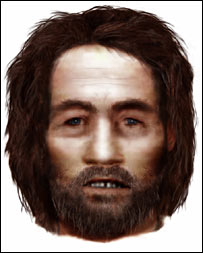
Even More Presumed Details of Ötzi's Final Fight (8/13/03)
Molecular biologist Thomas Loy (from
the University of Queensland's Institute of Molecular Bioscience
in Brisbane) who headed the DNA
research team (see next entry below) has given many interviews
in the last few days expanding on
his theory of what happened to the Iceman. According to Loy,
this is what happened to Ötzi (based on
conclusions he has drawn from his DNA research and his study
of Ötzi's weapons and tools):
1. The Fight
Loy concludes that
Ötzi encountered hunters from another area; they fought. "Rather than
a simple murder...it
looks like [Ötzi] may have put himself into a boundary situation where bloody battles often
occur," Loy told Reuters (reported on CNN.com). "Presumably he was in a combat situation
for between 24 to 48 hours before he died."
2. His Wounds
During the fight, Ötzi
was shot in the back with an arrow. He also received cuts on his hands, wrists, and rib cage.
Using his bow, he also shot "at least two different people and retrieved his arrow, but then
he shot at something else and missed, shattering his arrow" (Reuters, CNN.com). As one of
his last acts, Loy concluded that the Iceman tried to fashion one arrow from two broken ones.
3. His Companion(s)
Loy, who is an expert
on prehistoric tools and weapons, concluded that Ötzi could not have removed the arrow
from his back by himself. This suggests that he was traveling with someone. Additional
blood (not Ötzi's) found on his goatskin coat indicated to Loy that
Ötzi carried a wounded
companion some distance. What Loy doesn't answer (in his theory): Is this the same companion
who removed the arrow or an additional companion?
4. Type of Hunter
Loy studied the Iceman's
arrows and concluded that, since they were very lightweight and
quite long, they were
more suited to higher elevations (above the tree line). They wouldn't
have worked well in
a forest, because they could have been too easily deflected.
5. His Death
Loy told NPR: "I suspect
that as he realized his life was ending, he stopped, put his gear
[down], stacked it
neatly against a rock wall and lay down and expired."
DNA Tests Suggest:
Ötzi Died After Violent Fight But Not Alone (8/10/03)
Results of
recent DNA tests conducted by an Australian researcher have led to all sorts
of new speculation about Ötzi's final days. Like crime scene investigators, molecular biologist Thomas
Loy and his team (from the University of Queensland's Institute of Molecular Bioscience
in Brisbane) looked for blood traces on the Iceman, his tools, and weapons. During their investigation,
they saw further signs of trauma to Ötzi's body, including bruises (and cuts) on his abdomen
(especially on his rib area), which (they concluded) indicates that he may have been beaten. They found
DNA from four different people other than the Iceman, and they carried out each test twice to be certain
of their findings.
Dr. Loy told a reporter from USA Today, "We have been working
round the clock for the last three weeks to get these results. It was very exciting when the blood
samples came back positive for human DNA from four separate individuals."
Specifically, they took samples from the Iceman's antler-skinning
tool, his stone-tipped knife, two of his arrows (one broken), his axe handle, and his goatskin coat.
Using techniques devised especially for ancient DNA, the team found four different DNA sequences:
one on the knife blade, two different sequences on one arrow, and a fourth on Ötzi's goatskin
coat. (They also found a small tear in the coat which may have been the entry point of the arrowhead that
was found embedded in his shoulder.)
The Findings (as originally interpreted before 2010.)
Debating specialists have interpreted these findings in this way:
1. The two different blood samples on the arrow may indicate
that Ötzi killed two of his assailants and retrieved the arrow to use again.
2. The blood on his coat may indicate that Ötzi carried a
wounded friend on his shoulder for some distance.
Dr. Loy told news.com.au:
"On the basis of all my examinations,
[Ötzi's] specialty was hunting the high alpine passes for ibex and possibly chamois which would have
taken him into boundary conditions where other people would have disputed the territory. His gear
was stacked up neatly.
He didn't keel over, although he was probably tired, exhausted and hurt like
hell."
Stay tuned: The Discovery Channel is involved in this latest research
(it apparently paid for the
research done by Dr. Loy and his team). A one-hour documentary,
Iceman: Hunt for a Killer, will air in the U.S. on August 24. And on August 28th, the documentary
filmmaker will take a trip to the Ötzi's find spot in the Alps to look for more bodies, now that the European
heat wave this summer is melting the glacier even more.
Confirmed: Ötzi Was an "early Italian" (7/25/03) One of the
most important political questions about Ötzi is: who owns him. Austria and Italy fought a bitter
battle over custody, resolved when authorities confirmed that his find spot was located in Italy. That meant
Italy was allowed to claim the Iceman, build a large modern museum to exhibit him, and reap substantial
financial rewards. But the issue wasn't truly settled, because many people wondered where Ötzi
came from.
Was he a pre-Austrian (on his way to what is now Italy) or a pre-Italian (on his way
to the area that has become Austria)?
Now we know, thanks to research by Dr. Wolfgang Mueller from
the Research School of Earth
Sciences at the Australian National University in Canberra.
Dr. Mueller studied the mineral composition of Ötzi's dental
enamel and and one leg bone. He then compared this analysis to isotopes found in the environment north
and south of Ötzi's find spot.
"From the enamel it is possible to reconstruct the composition
of the water Ötzi drank and get clues about the earth where his food was grown," Dr Mueller said. "As
a result we now know Ötzi came from near to where he was found from the Eisack Valley [in the South
Tyrol part of Italy]. He spent his childhood there. And he spent his adulthood in Lower Vinschgau
[also in the Italian Tyrol]."
Translation: Ötzi lived his life in the area south of the
find spot, making him a very, very early Italian. Dr. Mueller also concluded that Ötzi was not a world traveler
(he hadn't hiked all over Europe) and hadn't spent extensive time at higher elevations.
The Iceman's Wounded Hand (2/2003)
The February 2003 issue of
the Smithsonian contains an article by Bob Cullen summarizing what has been discovered about
the Iceman. It is worth reading as a general summary of the findings, but most important is the
information it contains about a dagger found near Ötzi.
A filmmaker working on a documentary for the Discovery Channel
interviewed one of the men who helped recover the Iceman's body and learned that Ötzi may
have been holding a dagger in his hand when he was discovered. Dr Egarter Vigl re-examined the Iceman's
right hand in June 2002 and "found a small cut running from the palm of the right hand, just
below the index finger, over to the top side of the hand" (Smithsonian). About 1.5 inches long
and 6 mm. deep, the cut was discolored along the edges, indicating that the injury happened when the Iceman
was alive. Dr. Egarter told author Cullen, "I think that the wound was very painful. Two fingers
are nearly immobilized." X-rays also revealed two cuts on the underlying bones (of the palm and the
wrist).
Additional study of the Iceman's body would help clarify questions
surrounding the cause of death: If the officials at the South Tyrol Museum would grant permission,
the arrowhead could be removed and an endoscopy performed to determine if any nerves or blood vessels
were severed.
Sources:
Kate Wong "The Iceman's Last Stand: The Story of a famous corpse gets a surprising twist." page 26, Scientific American, November 2010.
How to Make a Mummy Talk (Deem, 1995),
Iceman (Fowler, 2000), National Geographic (June 1993), Smithsonian (February
2003),
10:12 AM, August 25, 2004. http://www.mummytombs.com/mummylocator/featured/otzi.discovery.htm


 ibex bones
ibex bones 
 fallen climber, especially
if a fresh snowfall covers the area. The body freezes and does not deteriorate;
many such mummies have been recovered. Even though this might be expected,
the sight of a dead person shocked the couple.
fallen climber, especially
if a fresh snowfall covers the area. The body freezes and does not deteriorate;
many such mummies have been recovered. Even though this might be expected,
the sight of a dead person shocked the couple.  was his medicine kit. At first,
researchers thought that the medicine kit ("two walnut-sized lumps," according to author
John Noble Wilford, "with a consistency somewhere between cork and leather")
was not medicine at all--but material to start fires. However, anthropologist
Luigi Capasso reported that the material was actually a birch fungus used
as a laxative and as a natural antibiotic. If you're interested in Ötzi,
you won't want to miss this article! (The New York Times, 12/8/98,
p. F3). A photo of the medicine kit is included with the article.
was his medicine kit. At first,
researchers thought that the medicine kit ("two walnut-sized lumps," according to author
John Noble Wilford, "with a consistency somewhere between cork and leather")
was not medicine at all--but material to start fires. However, anthropologist
Luigi Capasso reported that the material was actually a birch fungus used
as a laxative and as a natural antibiotic. If you're interested in Ötzi,
you won't want to miss this article! (The New York Times, 12/8/98,
p. F3). A photo of the medicine kit is included with the article.

